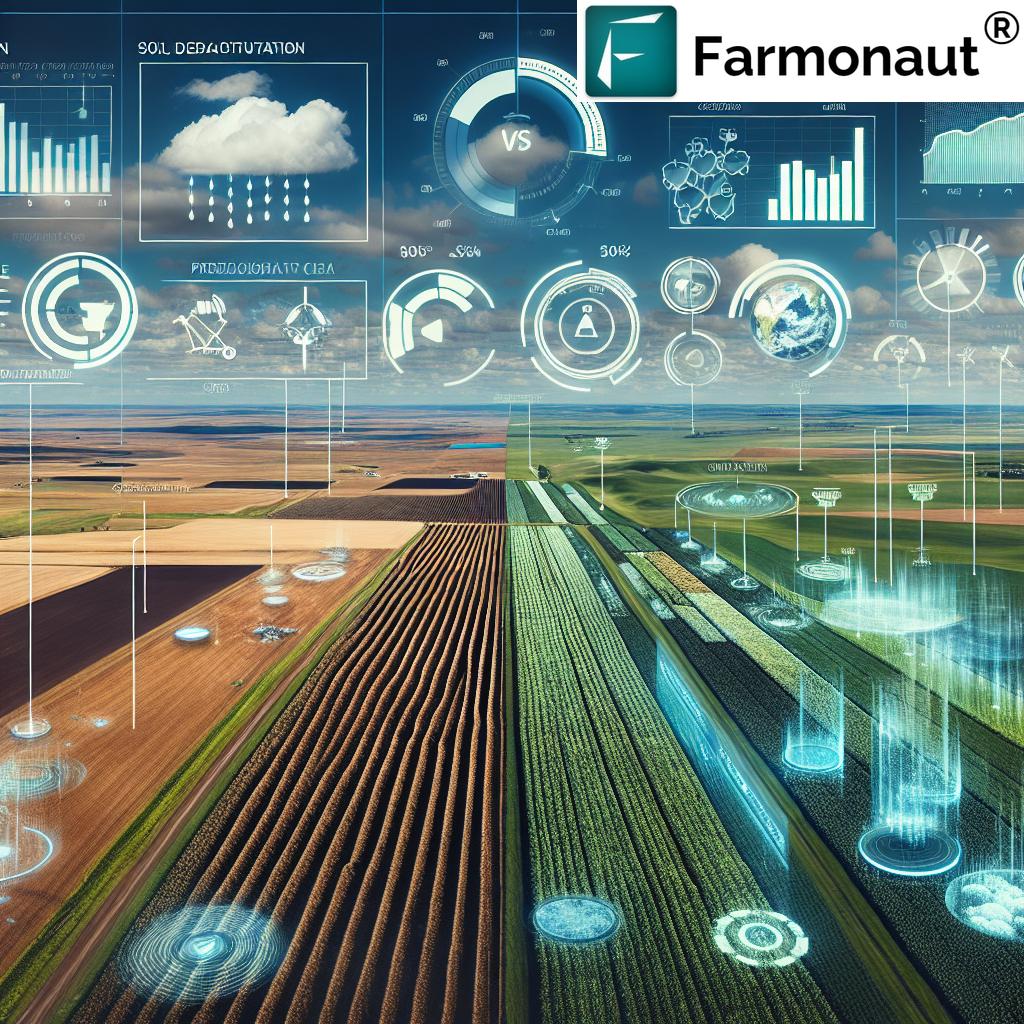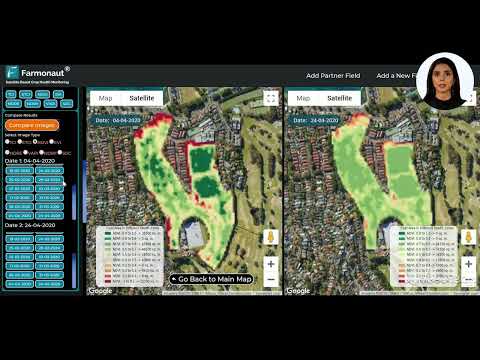Revolutionizing South Dakota Agriculture: Data-Driven Insights for Sustainable Land Management
“High-resolution USDA images have mapped soil characteristics across 77,000 square miles of South Dakota cropland.”
In the heart of America’s heartland, a quiet revolution is taking place. South Dakota, known for its vast prairies and rich agricultural heritage, is witnessing a transformation in how we approach farming and land management. At Farmonaut, we’re at the forefront of this change, leveraging cutting-edge technology to provide farmers with the tools they need to make informed decisions and drive sustainable practices.
As we delve into the world of data-driven agriculture, we’ll explore how innovative techniques are reshaping the landscape of South Dakota’s farms and beyond. From precision agriculture to advanced soil mapping, we’re uncovering new ways to optimize crop production while preserving our precious natural resources.
The Dawn of Data-Driven Agriculture in South Dakota
Traditional farming methods have served South Dakota well for generations, but as we face new challenges like climate change and the need for increased food production, it’s clear that we need to adapt. This is where data-driven agriculture comes into play, offering a wealth of insights that can help farmers make more precise decisions about their land and crops.
Recent research has highlighted the importance of accurate, data-driven decision-making for land use changes. By challenging traditional estimates and employing innovative visual analysis techniques, researchers have been able to map soil characteristics and cropland conversion trends with unprecedented accuracy. This nuanced understanding of land adaptation is crucial for developing sustainable farming practices that can withstand the test of time.

Precision Agriculture: A Game-Changer for South Dakota Farmers
Precision agriculture is at the heart of this agricultural revolution. By utilizing advanced technologies such as satellite imagery, GPS, and IoT sensors, farmers can now monitor their fields with incredible detail. This level of precision allows for targeted interventions, whether it’s applying fertilizer, managing pests, or optimizing irrigation.
At Farmonaut, we’re proud to offer cutting-edge solutions that support precision agriculture techniques. Our satellite-based farm management platform provides real-time insights into crop health, soil moisture levels, and other critical metrics. This data empowers farmers to make informed decisions that can significantly improve yields while reducing resource waste.
- Real-time crop health monitoring
- AI-based advisory systems
- Resource management tools
These tools are not just improving efficiency; they’re also contributing to more sustainable farming practices. By optimizing resource use, we can reduce the environmental impact of agriculture while maintaining or even increasing productivity.
Soil Mapping: Understanding the Foundation of Agriculture
One of the most significant advancements in agricultural research has been in the field of soil mapping. Using high-resolution USDA images, researchers have been able to create detailed maps of soil characteristics across vast areas of South Dakota cropland. This information is invaluable for farmers looking to optimize their planting strategies and manage their land more effectively.
Soil mapping provides insights into:
- Soil composition and structure
- Nutrient content and availability
- Water retention capabilities
- Potential for erosion
By understanding these factors, farmers can make more informed decisions about crop selection, rotation strategies, and soil management practices. This not only leads to better yields but also helps in preserving soil health for future generations.
Climate Change and Agriculture: Adapting to New Realities
Climate change poses significant challenges to agriculture in South Dakota and around the world. Changing weather patterns, increased frequency of extreme events, and shifts in growing seasons are just some of the issues farmers are facing. However, with data-driven approaches, we can better understand and adapt to these changes.
Farmonaut’s platform includes advanced weather forecasting and climate modeling tools that help farmers prepare for and mitigate the impacts of climate change. By analyzing historical data and current trends, we can provide valuable insights into:
- Optimal planting and harvesting times
- Drought-resistant crop varieties
- Water conservation strategies
- Pest and disease management in changing conditions
These insights are crucial for developing resilient agricultural systems that can thrive in the face of environmental challenges.
Land Use Change Analysis: Tracking Agricultural Evolution
Understanding how land use changes over time is essential for sustainable agriculture. Recent studies have revealed discrepancies between traditional estimates and actual land use changes in South Dakota. By employing advanced analysis techniques, researchers have been able to track cropland conversion trends with greater accuracy.
“Data-driven analysis revealed a 15% discrepancy in traditional estimates of land use changes in South Dakota agriculture.”
This more precise understanding of land use changes allows for:
- Better conservation planning
- More effective habitat preservation
- Informed policy-making for sustainable agriculture
At Farmonaut, we’re committed to providing tools that support this kind of in-depth analysis. Our satellite imagery and AI-powered analytics can help track land use changes over time, providing valuable data for both farmers and policymakers.

Agronomy Research Methods: Pushing the Boundaries of Agricultural Science
The field of agronomy is constantly evolving, with new research methods providing deeper insights into crop production and soil management. In South Dakota, agronomists are employing cutting-edge techniques to study everything from soil microbiology to plant genetics.
Some of the innovative research methods being used include:
- Advanced genetic sequencing for crop improvement
- Remote sensing for large-scale crop health assessment
- Machine learning algorithms for yield prediction
- Precision farming experiments using variable rate technology
These research methods are not only advancing our understanding of agriculture but are also directly informing farming practices. At Farmonaut, we stay abreast of the latest agronomic research to ensure our platform reflects the most current scientific knowledge.
Agricultural Policy and Sustainability: Shaping the Future of Farming
The insights gained from data-driven agriculture are not just valuable for individual farmers; they also play a crucial role in shaping agricultural policy. In South Dakota and across the United States, policymakers are increasingly relying on scientific data to craft regulations and incentives that promote sustainable farming practices.
Key areas where data-driven insights are influencing policy include:
- Conservation programs
- Water management regulations
- Crop insurance policies
- Subsidies for sustainable farming practices
By providing accurate, real-time data on land use, crop health, and environmental impacts, platforms like Farmonaut are helping to bridge the gap between science and policy. This data-driven approach ensures that agricultural policies are grounded in reality and can effectively address the challenges facing modern farmers.
Environmental Impact of Farming: Balancing Production and Conservation
As we strive to increase agricultural productivity to meet growing food demands, it’s crucial that we also consider the environmental impact of farming. Data-driven agriculture offers a path to achieving this balance, allowing farmers to optimize their practices while minimizing negative effects on the environment.
Some ways in which data-driven approaches are helping to reduce the environmental impact of farming include:
- Precision application of fertilizers and pesticides to reduce runoff
- Optimized irrigation systems to conserve water
- Improved soil management practices to prevent erosion
- Targeted habitat conservation based on land use analysis
Farmonaut’s platform includes tools for tracking and managing these environmental factors, helping farmers to make decisions that are both productive and sustainable. Our carbon footprinting feature, for example, allows agribusinesses to monitor their emissions and take steps towards more environmentally friendly practices.
The Role of Technology in Modern Agriculture
The agricultural revolution we’re witnessing in South Dakota and beyond would not be possible without significant technological advancements. From satellite imagery to artificial intelligence, technology is transforming every aspect of farming.
Key technologies driving this revolution include:
- Satellite-based crop monitoring
- IoT sensors for real-time field data collection
- AI and machine learning for predictive analytics
- Blockchain for supply chain transparency
- Drones for aerial imaging and crop spraying
At Farmonaut, we’re proud to be at the forefront of this technological revolution. Our platform integrates many of these cutting-edge technologies to provide farmers with a comprehensive suite of tools for managing their operations.
For those interested in leveraging our technology, we offer several ways to access our services:
For developers looking to integrate our data into their own applications, we also offer an API with comprehensive documentation.
The Future of Agriculture in South Dakota and Beyond
As we look to the future, it’s clear that data-driven agriculture will play an increasingly important role in feeding the world while preserving our planet. In South Dakota, we’re already seeing the benefits of this approach, with farmers adopting new technologies and practices that are improving yields, reducing costs, and promoting sustainability.
Some trends we expect to see in the coming years include:
- Increased adoption of precision agriculture techniques
- Greater integration of AI and machine learning in farm management
- More emphasis on sustainable and regenerative farming practices
- Continued development of drought-resistant and climate-adaptive crop varieties
- Expansion of data-sharing networks among farmers and researchers
At Farmonaut, we’re committed to staying at the forefront of these developments, continually improving our platform to provide farmers with the most advanced and effective tools available.
Comparison: Traditional vs. Data-Driven Agricultural Practices in South Dakota
| Aspect | Traditional Practices | Data-Driven Practices |
|---|---|---|
| Soil Analysis Method | Visual inspection and basic soil tests | High-resolution USDA imagery and advanced soil mapping techniques |
| Crop Selection | Based on historical patterns and local knowledge | AI-driven recommendations based on soil data, climate projections, and market trends |
| Water Management | Scheduled irrigation based on general observations | Precision irrigation guided by real-time soil moisture sensors and weather forecasts |
| Fertilizer Application | Uniform application across fields | Variable rate application based on soil nutrient maps and crop health data |
| Yield Prediction | Estimates based on previous years’ harvests | Machine learning models using multiple data points for accurate forecasting |
Embracing the Agricultural Revolution
The revolution in South Dakota agriculture is not just about technology; it’s about a new way of thinking about farming. It’s about understanding that every field is unique, every season brings new challenges, and every decision we make has long-lasting impacts on our land and communities.
By embracing data-driven agriculture, we’re not just improving yields and reducing costs; we’re building a more resilient and sustainable food system for future generations. At Farmonaut, we’re proud to be part of this journey, providing farmers with the tools and insights they need to thrive in this new era of agriculture.
As we continue to push the boundaries of what’s possible in agriculture, we invite you to join us in this exciting journey. Whether you’re a farmer looking to optimize your operations, a researcher exploring new frontiers in agronomy, or a policymaker shaping the future of agriculture, Farmonaut is here to support you with cutting-edge technology and data-driven insights.
Farmonaut Subscriptions
Frequently Asked Questions
Q: How does data-driven agriculture benefit South Dakota farmers?
A: Data-driven agriculture provides South Dakota farmers with precise insights into soil health, crop conditions, and weather patterns. This allows for more efficient resource use, improved yields, and better adaptation to climate change challenges.
Q: What types of data are used in precision agriculture?
A: Precision agriculture utilizes various data types, including satellite imagery, soil sensor readings, weather data, and historical yield information. These data sources are combined to provide comprehensive insights for farm management.
Q: How does Farmonaut contribute to sustainable farming practices?
A: Farmonaut’s platform supports sustainable farming by offering tools for precision resource management, crop health monitoring, and carbon footprint tracking. This helps farmers optimize their operations while minimizing environmental impact.
Q: Can small-scale farmers benefit from data-driven agriculture?
A: Absolutely! Farmonaut’s solutions are designed to be accessible and affordable for farmers of all scales. Our platform can help small-scale farmers make more informed decisions and improve their productivity without significant capital investment.
Q: How does climate change impact agriculture in South Dakota, and how can data help?
A: Climate change is affecting growing seasons, precipitation patterns, and pest pressures in South Dakota. Data-driven approaches can help farmers adapt by providing insights into optimal planting times, drought-resistant crop varieties, and water conservation strategies.
As we conclude this exploration of data-driven agriculture in South Dakota, it’s clear that we’re on the cusp of a new era in farming. By harnessing the power of technology and data, we can create a more sustainable, productive, and resilient agricultural sector. At Farmonaut, we’re committed to leading this charge, providing farmers with the tools they need to thrive in the 21st century and beyond.
Join us in revolutionizing agriculture, one data point at a time.






